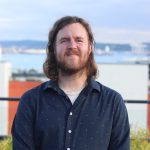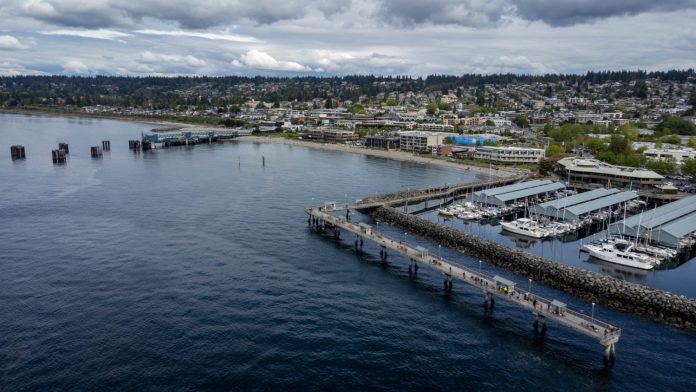
Months after enacting some modest upzones that would allow additional types of housing around existing commercial hubs, the Edmonds City Council is already set to reconsider that move. While the second look is focused on one specific neighborhood for now, the reassessment has the potential to unravel the city’s entire growth plan, with residents from other neighborhoods already lining up to request that their areas also get reconsidered as places for additional housing density and commercial development.
The new housing framework included in Edmonds’ newly adopted Comprehensive Plan — referred to as “hubs and centers” — represents the biggest change in land use policy that the city has seen in decades. The plan focuses additional density around existing pockets of commercial development, areas with access to both transit lines and other amenities.
The small hubs and slightly larger centers are not a complete sea change. New developments could be just three stories high, in most cases, with incentives available to add an additional story in specific areas. But it’s a big break from the past, when previously Edmonds had concentrated almost all of its capacity for new homes along busy and dangerous State Route 99. Most of the development capacity remains in that area, but the hubs and centers plan was a small step toward allowing broader density elsewhere in the city.
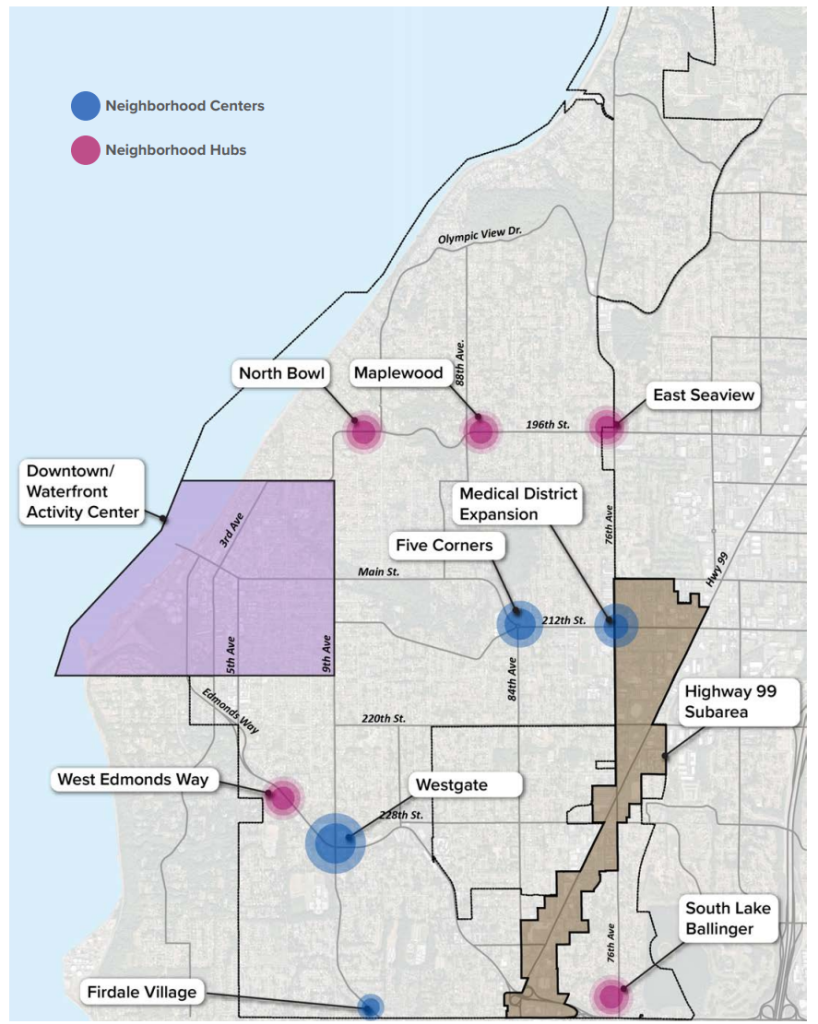
The commercial center of the North Bowl neighborhood, directly up the hill from downtown along State Route 104, currently consists of a gas station and two strip mall-style buildings. Immediately adjacent to Edmonds Elementary school, the new “hub” only extends about one block in either direction from the intersection of Puget Drive and Olympic View Drive. But in the weeks since the adoption of an interim ordinance putting new zoning in place in January, North Bowl residents have been petitioning for it to be scaled back, citing justifications that include the narrowness of Grandview Street and the location of a nearby creek.
“I can tell you, from my time in Edmonds, that the people of Edmonds have been fighting against development of this scale for generations. And I’m grateful for the leaders of the past who have had the courage to resist the developers and create the community that we have today,” North Bowl resident Scott Urquhart told the city council in March. “We’re concerned that the proposed changes are going to destroy our neighborhood.”
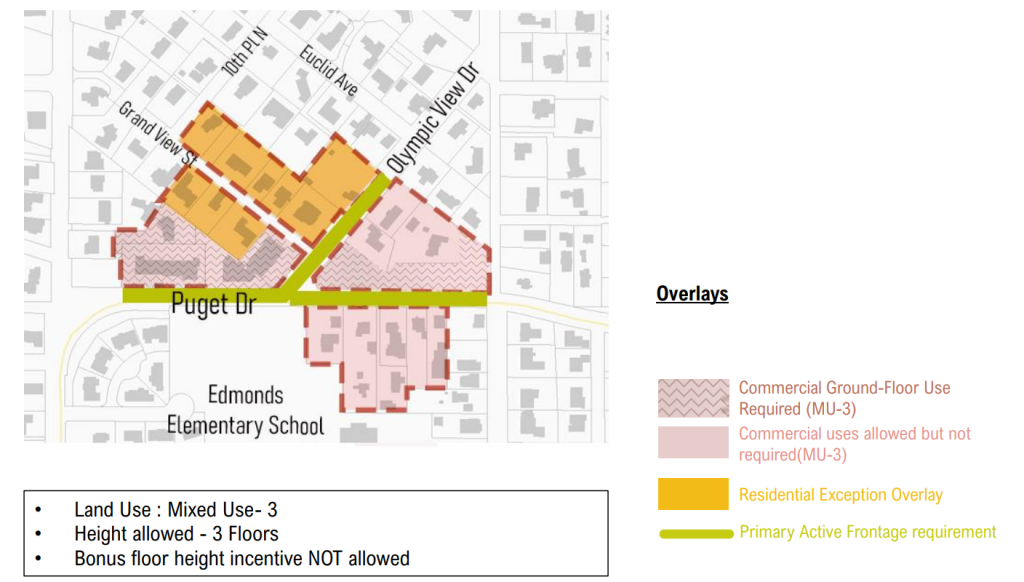
In pushing for the hub to be reconsidered, many residents instead advocated for density to be sited where it’s always been sited in Edmonds: along the state highway. “Why did the planning department ignore — or maybe ignore’s not the right word — but avoid the housing possibilities on Highway 99?” North Bowl resident Marty Ronish said at the same meeting. “Needless to say, we’d rather they have it than we have it.”
Those requests gained traction. Early this spring, Edmonds Council President Niel Tibbott put out a call for his colleagues to submit ideas for proposed changes to the Comprehensive Plan in 2025, and four separate councilmembers requested that the city look at changes in the North Bowl. Councilmember Michelle Dotsch, the only vote against the Comprehensive Plan itself back in December, requested that the city remove the hub from the growth plan entirely.
“I think there’s a lot of agreement that, especially after looking at the surrounding area, that this is one of those Comp Plan hub ideas that needs more consideration, and that’s what we’re asking staff to do, is help us with that,” Council President Neil Tibbott said ahead of a 6-0 vote to move forward with reassessing the North Bowl hub.
Founded in 1890, which makes it the oldest city in Snohomish County, Edmonds has a reputation for being anti-development, a fact that is evidenced by its slow growth compared to other similarly-sized cities around the region. Since 2000, the city has grown by just 0.4% per year, as the county as a whole grew more than four times as fast.

Opposition to new housing in Edmonds often takes the form of ardent environmentalism, even as a lack of infill development in Puget Sound cities increases development pressure on the urban fringe, leading to more sprawl. In 2024, a former Edmonds councilmember wrote an op-ed from the perspective of “the environment” suggesting that if Edmonds allows more types of housing, the city’s water sources will be “tainted by density.”
With North Bowl officially on the list for reconsideration, other neighborhoods may soon follow.
This week, numerous residents of the area around Swedish Hospital Edmonds provided public comment at the city council, pushing for zoning changes there to be scaled back. The expanded “Medical District” center also features three story zoning, with a very small number of parcels where four and five story buildings would be allowed. New homes here would be close to the Stride BRT line along SR 99 as well as Edmonds Woodway High School and a Winco grocery store.
“We’re not opposed to development,” Medical District resident Margo Radovic said Monday night. “What we ask is for thoughtful, appropriate growth that fits the scale of our community and space. The level of development being proposed under Mixed Use 3 [zoning] would significantly increased traffic and further compromise pedestrian safety for future generations of children and families.”
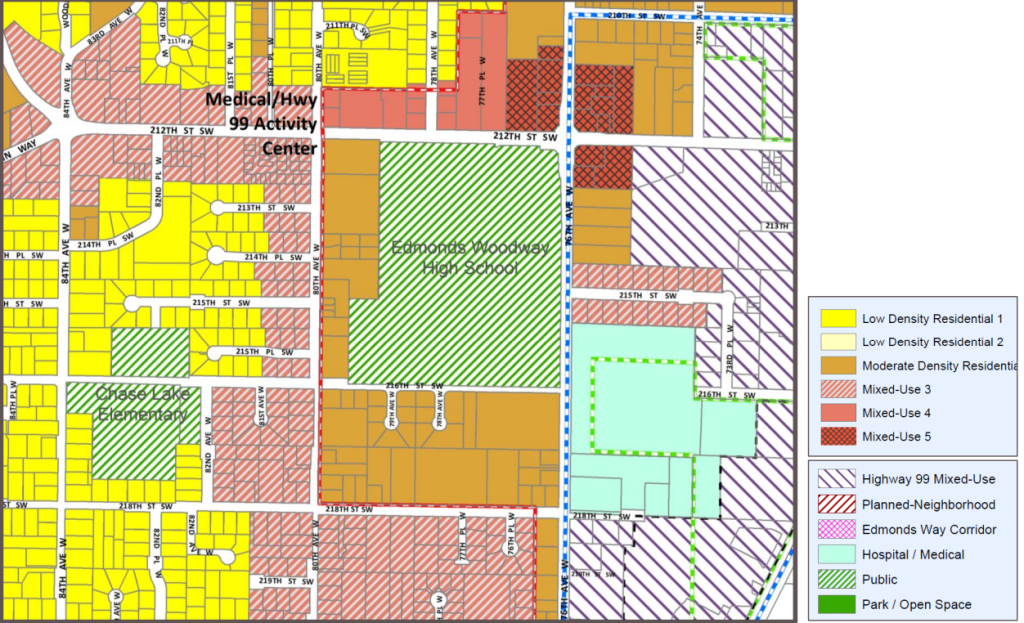
Dotsch, in addition to asking for the North Bowl to be removed, also pushed for a Comp Plan amendment that would have reassessed part of the Medical District. Also on the list of councilmember suggestions? Part of the Five Corners center, also from Dotsch, and part of the Westgate center, from Councilmember Vivian Olsen.
“This is an area that has been popular with new and younger families that Edmonds is looking to provide housing options for with a yard where a swing set can be placed, and light can pass through,” Dotsch wrote in explaining her request on the Medical District. “This incompatible higher development within the same narrow cul-de-sacs to the East will crowd out those other lots and cast shadows upon incompatible neighboring properties.”
Making moves to densify the city’s previously sacrosanct single-family neighborhoods didn’t come about because of concerns around housing affordability within Edmonds, but because of the state legislature. House Bill 1220, approved in 2021, requires cities to plan for the types of housing that future residents will need based on their expected income level. Since most lower-income residents can’t afford the single-family homes that dominate Edmonds’ neighborhoods, the city was required to zone for apartments, with the area around SR 99 not quite providing enough capacity.
However, residents in just about every hub and center seem to have a reason that their area shouldn’t be included.
That doesn’t mean there isn’t any support for the hubs and centers approach within the city. Edmonds resident Chris Ziobro called into this week’s council meeting to push for the city to retain the North Bowl hub, citing a need for the entire city to share a part in increasing density — something that absolutely hasn’t been the case in Edmonds for decades.
“Apparently that’s on the table now to be amended, and I wanted to speak up to that, because it feels really unjust,” Ziobro said. “The entire community has to grow. I mean, there’s population [increase], it’s going to be more dense, and we all have to deal with that. And for one part of the city to feel entitled enough to not have to carry part of that load seems unjust.”
Ryan Packer has been writing for The Urbanist since 2015, and currently reports full-time as Contributing Editor. Their beats are transportation, land use, public space, traffic safety, and obscure community meetings. Packer has also reported for other regional outlets including Capitol Hill Seattle, BikePortland, Seattle Met, and PubliCola. They live in the Capitol Hill neighborhood of Seattle.


